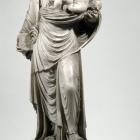Agostino Busti, known as il Bambaia, Madonna Taccioli
Agostino Busti, known as il Bambaia, Madonna Taccioli, marble, circa 1522 (inv. n. 1999)
The sculptural group has had an erratic life, changing hands frequently since it was commissioned for the head of the Birago sepulchre in 1522 (Milan, San Francesco Grande; now Isola Bella, Borromeo collection). Acquired by the museum in 1999, the work represents the Madonna with Child, but the identification of the subject can all but be taken for granted. The religious attributes and position of the female figure recall ancient Roman sculptures. Although there is no record of the artists sojourn in Rome, it is certain that he had the opportunity to study classical models, assimilating the technical and poetic teachings of Michelangelo Buonarroti. The results of these studies are visible in the complex classical arrangement of the drapery and the effective monumental representation of the subjects. The mastery in handling the marble, overcoming the technical difficulties of the raw material with prodigious results, reaches its culmination in the representation of the skin and the almost transparent rendering of the veil. At the centre of the base is the head of the screaming Medusa, the sculptural quality of which recalls the contemporary chasing executed by Lombard goldsmiths.








